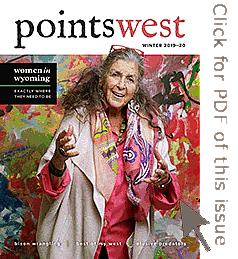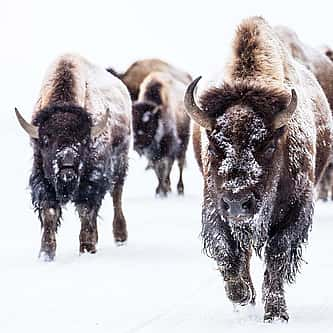
Less is More When ‘Wrangling’ Bison – Points West Online
Originally published in Points West magazine
Winter 2019–20
How would you round up 95 bison after their escape from a private ranch, and return them to their enclosure? That’s what folks from the New York State Department of Agriculture & Markets wanted to know in August 2019. So they called Mary Robinson, then the Housel Director of the McCracken Research Library, since retired.
Authorities with no bison-wrangling experience were looking for help in capturing the behemoths, which were wandering through greener pastures in upstate New York. Robinson referred them to rangers in Yellowstone National Park, who know a few things about moving bison around.
Or, more accurately, helping bison move wherever bison want to move, said Tim Reid, Yellowstone’s bison program manager.
“Pressuring bison is typically not a best practice,” Reid said. “It usually ends up frustrating them and you, and they very seldom fold to pressure.”
Yellowstone’s approximately 5,000 bison generally roam freely throughout the park. But rangers have sometimes had to persuade bison away from private lands after they’ve left the park’s northern and western boundaries. Rangers also have experience moving the animals through enclosures for quarantines, and into trailers for transport to tribal lands as part of overall management efforts.

“Less is more. It’s not the stereotype of whooping and hollering. You just work with their nature,” Reid said.
Bison prefer to travel over familiar ground, and don’t respond well to being scared or intimidated across new terrain, he said.
“Bison are the largest land mammal in North America. There’s really not a whole lot that can make them afraid,” Reid said.
Because herds are matriarchal, luring the lead cow to follow a preferred course is the best way to move the entire group. “It’s definitely more art than science,” he said.
Being patient and quiet is important, as is planning ahead. Figuring out days in advance how and where you want the herd to move—as well as setting up enclosures and enticements toward that goal—are key.
The New York herd’s rancher eventually used apples, molasses-soaked oats, and other treats to lure many of his bison back. Others were darted with tranquilizers—an option the National Park Service generally avoids.
Reid said he loves working with Yellowstone bison, because “it’s a chapter of wildlife conservation that’s being written as we speak.”
Post 340
Written By
Nancy McClure
Nancy now does Grants & Foundations Relations for the Center of the West's Development Department, but was formerly the Content Producer for the Center's Public Relations Department, where her work included writing and updating website content, publicizing events, copy editing, working with images, and producing the e-newsletter Western Wire. Her current job is seeking and applying for funding from government grants and private foundations. In her spare time, Nancy enjoys photography, reading, flower gardening, and playing the flute.

